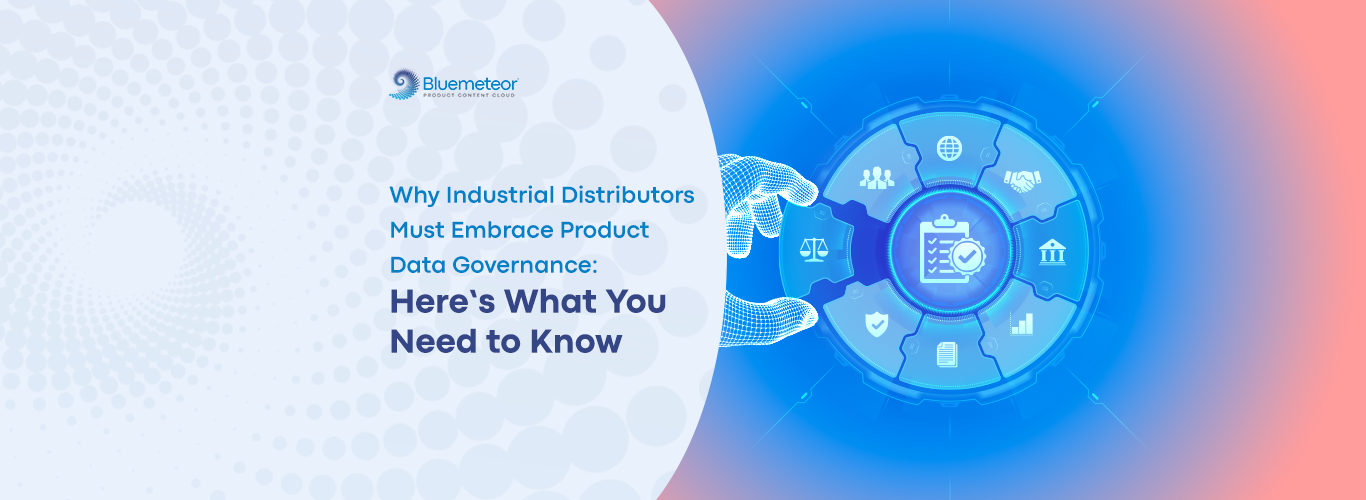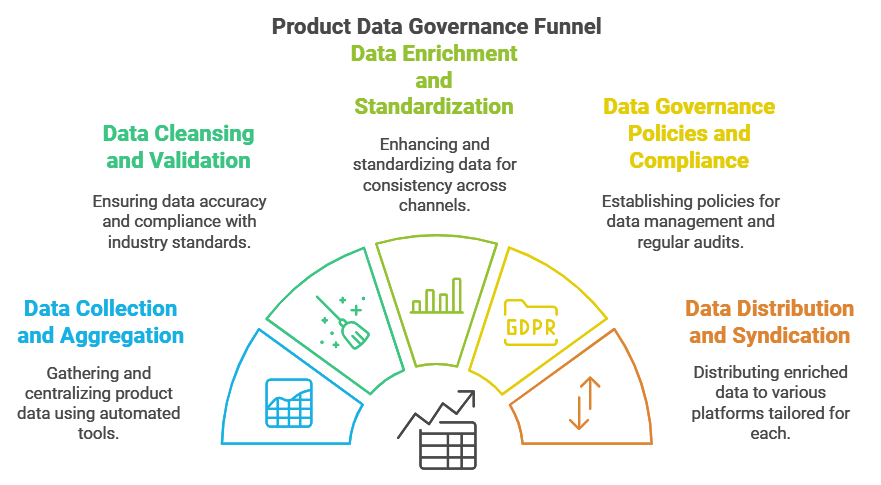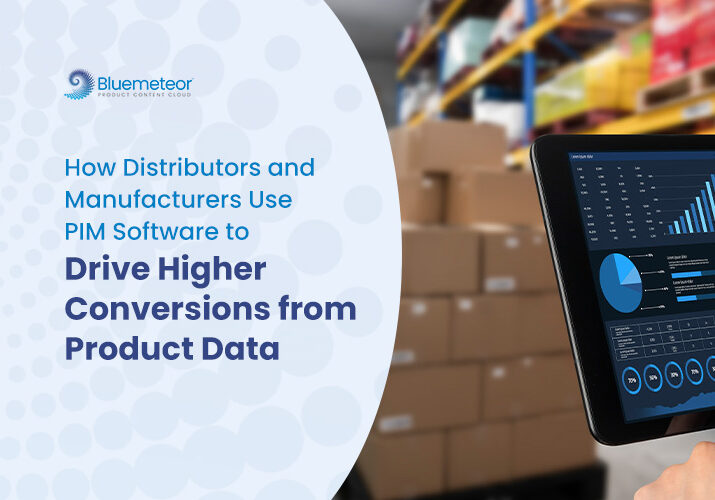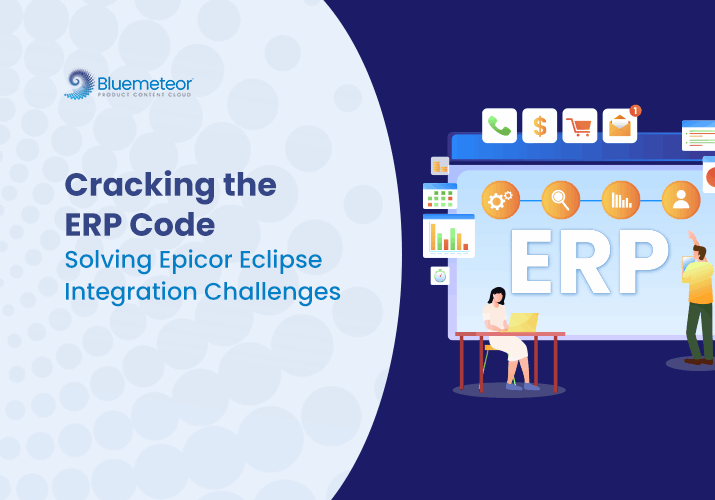Why Industrial Distributors Must Embrace Product Data Governance – Here’s What You Need to Know

Product data governance is a powerful framework for industrial distributors to streamline operations, win customer trust, and stay competitive. But what exactly is it, and why should it matter to you? This guide breaks down definitions, frameworks, and practical steps to help you master modern data governance in a way that brings real value to your business.
What is Product Data Governance?
It is a foundation for reliable data.
Simply put, Product data governance involves the technical processes, systems, and protocols for maintaining accurate, consistent, and secure product data across your entire organization.
While its purpose is business-focused—ensuring reliable, high-quality data for customer experiences—it’s driven by a series of technical frameworks and data models that organize and standardize product information.
In the case of industrial distribution, effective data governance often involves creating data hierarchies (think categories, sub-categories, and attributes), adhering to data standards (like BMECat ETIM, GS1, or ACES/PIES), and using metadata to streamline search and retrieval.
Why Does Product Data Governance Matter for Industrial Distributors?
Let us explore some of the key reasons why product data governance is critical for industrial distributors, particularly in sectors like power transmission, HVAC, bearings, and electrical supplies.
- Ensures Consistent Customer Experience – Customers rely on accurate data when making purchasing decisions. If your specs or prices are off, it can lead to mistrust, returns, or even lost clients.
- Reduces Operational Inefficiencies – When teams are working off inconsistent data or unclear roles, it slows everything down. By standardizing your data, you reduce bottlenecks, minimize errors, and streamline workflows.
- Supports Compliance and Reduces Risk – Industrial distributors often deal with strict compliance standards (like ETIM for electrical supplies or AHRI for HVAC). Failing to adhere to these can mean fines, reputational damage, and even operational restrictions.
- Lays the Foundation for Growth – Reliable product data is not just a short-term fix; it is essential for scaling up. As your business grows, strong data governance makes it easier to add new products, expand into new markets, and maintain consistency.
Inefficiencies, inconsistencies, and hidden gaps in product data management can cost industrial distributors more than just time – they impact:
- Revenue,
- Customer trust, and
- Growth potential.
On the other hand, with the right approach, product data governance transforms from a costly burden into a competitive edge, rising to new growth and efficiency.
Key Benefits of Product Data Governance
Let us explore the benefits that product data governance offers to industrial distributors:
| Consistent and Accurate Data | Standardized data reduces errors, enabling teams and customers to rely on correct product information across platforms. |
| Increased Efficiency | Centralized data management minimizes manual corrections, allowing quick, synchronized updates across systems. |
| Compliance with Industry Standards | Ensures adherence to industry standards like ETIM or AHRI, reducing regulatory risks and building partner trust. |
| Streamlined Data Syndication | Automatic updates across e-commerce, partner networks, and catalogs maintain consistent information everywhere. |
| Improved Data Security | Protocols protect sensitive product information, reducing risks of data breaches and unauthorized changes. |
| Scalability for Growth | Structured data models support catalog expansion, making it easy to manage large or growing product lines. |
Best Practices for Implementing Product Data Governance
So how do you get started?
Below, we cover a mix of practical steps to set up a data governance strategy that fits the unique needs of industrial distributors.
1. Define Clear Data Ownership Roles
One of the main challenges in data governance is that product data can easily get “lost” between teams. Sales might update pricing, while inventory tracks stock levels, and the marketing team updates product descriptions.
Without clear roles, data inconsistencies can easily sneak in.
Assign specific teams or individuals as data stewards responsible for data accuracy, quality, and availability.
For example, you might assign one team to manage pricing updates and another to oversee product specifications.
2. Create a Centralized “Source of Truth”
When data is stored in multiple systems or silos, teams work with conflicting information, leading to poor customer experiences and wasted time.
A centralized “source of truth” for product data makes sure that everyone accesses the same information.
Consider implementing a Product Information Management (PIM) or Product Experience Management (PXM) system.
These solutions store product data in a single repository and integrate with your other systems (like ERP and e-commerce) to keep everything aligned.
For instance, Bluemeteor’s Product Content Cloud provides a specific location where all product data is managed, syndicated, and governed. This way, marketing, sales, and warehouse teams always have access to consistent data.
3. Automate Data Quality Checks
Manual data entry and updates leave too much room for human error, and as your product catalog grows, it becomes difficult to keep track of everything manually.
Automate data quality checks to catch errors as they happen. Many PIM systems offer automation tools that validate new data entries, flag inconsistencies, and run routine checks to maintain data quality over time.
For example, if you distribute HVAC parts, automated checks can ensure that all entries for specifications like energy ratings or dimensions match the industry standards, reducing customer complaints and returns.
4. Implement a Data Funnel to Drive Business Insights
A data funnel allows you to track how information flows from raw data to actionable insights, from manufacturer specifications to the final customer-facing descriptions.
Steps to Set Up a Data Funnel
- Data Collection: Gather data from trusted sources like manufacturers, suppliers, and market standards.
- Data Cleaning: Use automated tools to clean data, eliminating duplicates, outdated information, or inaccuracies.
- Data Distribution: Ensure data flows seamlessly to all relevant systems, from your website to CRM and customer service platforms.
- Data Analysis: Use your cleaned, centralized data to understand product trends, performance, and customer needs.
Example:
A data funnel helps you track product demand, identify high-performing products, and adjust inventory accordingly – saving you time, money, and resources.
5. Maintain Compliance with Industry Standards
Whether it is ETIM for electrical parts or PPIF for plumbing, industry standards exist for a reason—they keep your business accountable and safe.
Standardize your data across systems to meet regulatory requirements and reduce compliance risks.
Some PIM solutions offer built-in compliance tools that help you automatically align product data with industry standards, minimizing manual adjustments.
For distributors managing power transmission products, data standards ensure that part specifications are consistent with industry norms. This reduces the chances of errors when selling to other businesses and improves your overall reliability.
6. Establish a Robust Information Architecture
Information architecture (IA) refers to how information is organized, structured, and labeled within your systems.
A well-defined IA makes it easier for your teams to find, use, and manage product data, ensuring that everyone is on the same page.
- Develop a Clear Taxonomy: Create a hierarchical structure for categorizing products, which simplifies navigation and data retrieval. For example, organize HVAC products by type, brand, and application.
- Create User-Centric Navigation: Design interfaces that reflect how users think and search for information. Intuitive navigation minimizes training time and enhances user experience.
- Document Data Relationships: Clearly outline how different data points relate to one another, such as product specifications, categories, and associated documentation. This fosters better understanding and usage among team members.
Benefit? This setup not only speeds up internal searches but also enhances customer access to relevant product information.
Product Data Governance Funnel
Visualizing your product data governance process can provide clarity and direction. Here is a structured funnel that outlines the key stages involved in effective product data governance:

PRODUCT DATA GOVERNANCE FUNNEL
1. Data Collection and Aggregation
- Gather product attributes, technical specs, images, and descriptions.
- Use automated tools or PIM software to import data for centralization.
- Considerations: Standardize data formats early to prevent inconsistencies.
2. Data Cleansing and Validation
- Apply data quality checks to eliminate duplicates, correct errors, and complete missing fields.
- Validate against compliance standards (e.g., BMEcat, ETIM) relevant to industry requirements.
3. Data Enrichment and Standardization
- Enhance data with detailed descriptions, categories, and SEO keywords.
- Apply a uniform taxonomy and categorization strategy for cross-channel consistency.
4. Data Governance Policies and Compliance
- Develop policies for data entry formats, access permissions, and quality thresholds.
- Regularly audit data and update it to remain compliant with standards and internal rules.
5. Data Distribution and Syndication
- Syndicate enriched and validated product data to e-commerce platforms, ERP systems, and other distribution channels.
- Tailor product content for specific channels to enhance customer experience.
6. Data Quality Monitoring and Feedback Loop
- Track key metrics (e.g., data accuracy, completeness) to ensure standards are met.
- Collect feedback from stakeholders (like sales and customer service) to improve data processes.
Key Features to Look for in a Product Data Governance Tool
As you assess product data governance tools, here are some essential features to keep in mind:
- Seamless Integration and Syndication: Connects with PIM, ERP, e-commerce, and other systems for smooth data flow across channels.
- Scalability and Flexibility: Supports large volumes of data and adapts to diverse product types, categories, and formats as business needs grow accommodating new products, clients, or regions.
- Advanced Data Quality and Validation Tools: Offers robust, automated quality checks, deduplication, and validation against industry standards for reliable data accuracy
- Comprehensive Compliance and Audit Trail: Tracks all data changes, logs user activity, and enforces compliance with data standards and regulations, such as GDPR or industry-specific norms.
- Automation and AI: Many modern tools now offer AI-driven quality checks, predictive analytics, and suggestions, which make data governance more manageable.
How Bluemeteor Can Support Your Data Governance Strategy
Bluemeteor’s Product Content Cloud simplifies data governance by offering a cloud-based, centralized platform for managing, syndicating, and governing your product data.
With Bluemeteor Product Content Cloud, you can:
- Achieve Consistency: Keep all teams on the same page with a sole source of truth.
- Automate and Scale: As your business grows, Product Content Cloud adapts to handle more products and more data.
- Stay Compliant: Built-in compliance tools ensure your data meets industry standards.
If you are ready to take control of your product data governance, contact Bluemeteor today to see how Product Content Cloud can transform your business operations.
The Takeaway: Data Governance as a Competitive Advantage
Industrial distributors today face fierce competition, and data governance is more than just a technical process – it is a strategic advantage.
By implementing strong data governance, you are setting your business up for better efficiency, stronger customer relationships, and scalable growth.
Ready to get started? Book your free demo today!
Related Articles
Recent Post
Categories




